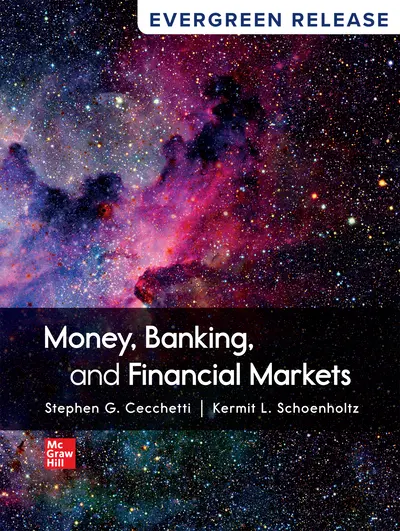My Account Details

ISBN10: 1266544453 | ISBN13: 9781266544453

Money, Banking and Financial Markets
Product not yet available for student view. Change to an older release to view student options.
- Lowest Price!
McGraw Hill eBook
Textbook Rental (150 Days Access)
- Rent for a fraction of the printed textbook price
- Complete text bound in hardcover or softcover
Loose-Leaf Purchase
Unbound loose-leaf version of full text
Shipping Options
- Standard
- Next-day air
- 2nd-day air
Orders within the United States are shipped via FedEx or UPS Ground. For shipments to locations outside of the U.S., only standard shipping is available. All shipping options assume the product is available and that processing an order takes 24 to 48 hours prior to shipping.
Note: Connect can only be used if assigned by your instructor.
Connect (180 Days Access)
- Digital access to a comprehensive online learning platform
- Includes homework, study tools, eBook, and adaptive assignments
- Download the free ReadAnywhere app to access the eBook offline
Connect + Loose-Leaf
- Comprehensive online learning platform + unbound loose-leaf print text package
- Connect includes homework, study tools, eBook, and adaptive assignments
- Download the free ReadAnywhere app to access the eBook offline
Shipping Options
- Standard
- Next-day air
- 2nd-day air
Orders within the United States are shipped via FedEx or UPS Ground. For shipments to locations outside of the U.S., only standard shipping is available. All shipping options assume the product is available and that processing an order takes 24 to 48 hours prior to shipping.
McGraw Hill eBook
Details:
- Normally the lowest price option for student
- Integrates in your LMS
- Accessible tools for students, including read-aloud functionality, jump links and dynamic note-taking and highlighting features
Textbook Rental (150 Days Access)
Details:
- Rentable option
- Hardcopy and softcover formats
Loose-Leaf Purchase
Details:
- Unbound loose-leaf version of full text
Connect (180 Days Access)
Details:
- Integrates in your LMS
- Prebuilt courses, presentation slides and instructor resources
- Test question banks, adaptive assignments, essay prompts, video content and more interactive exercises specific to your course subject
- eBook access (with included ReadAnywhere app)
- Print book add-on availability
- Remote proctoring
Connect + Loose-Leaf
Details:
- Comprehensive online learning platform + unbound loose-leaf print text package
- Connect includes homework, study tools, eBook, and adaptive assignments
- Download the free ReadAnywhere app to access the eBook offline
* The estimated amount of time this product will be on the market is based on a number of factors, including faculty input to instructional design and the prior revision cycle and updates to academic research-which typically results in a revision cycle ranging from every two to four years for this product. Pricing subject to change at any time.
In a world where money, banking, and financial markets are in constant flux, this release introduces cutting-edge features to keep pace with evolving dynamics. Continuing its distinctive approach, the text emphasizes the Five Core Principles, delivers an early introduction to risk, offers an integrated global perspective, and seamlessly integrates FRED data. This title boasts an innovative approach to enhancing coherence, relevance, and timeliness in the study of Money and Banking for economics students.
1. An Introduction to Money and the Financial System
2. Money and the Payments System
3. Financial Instruments, Financial Markets, and Financial Institutions
PART II: INTEREST RATES, FINANCIAL INSTRUMENTS, AND FINANCIAL MARKETS
4. Future Value, Present Value, and Interest Rates
5. Understanding Risk
6. Bonds, Bond Prices, and the Determination of Interest Rates
7. The Risk and Term Structure of Interest Rates
8. Stocks, Stock Markets, and Market Efficiency
9. Derivatives Futures, Options, and Swaps
10. Foreign Exchange
PART III: FINANCIAL INSTITUTIONS
11. The Economics of Financial Intermediation
12. Depository Institutions Banks and Bank Management
13. Financial Industry Structure
14. Regulating the Financial System
PART IV: CENTRAL BANKS, MONETARY POLICY, AND FINANCIAL STABILITY
15. Central Banks in the World Today
16. The Structure of Central Banks The Federal Reserve and the European Central Bank
17. The Central Bank Balance Sheet and the Money Supply Process
18. Monetary Policy Stabilizing the Domestic Economy
19. Exchange Rate Policy and the Central Bank
PART V: MODERN MONETARY ECONOMICS
20. Money Growth, Money Demand, and Modern Monetary Policy
21. Output, Inflation, and Monetary Policy
22. Understanding Business Cycle Fluctuations
23. Modern Monetary Policy and the Challenges Facing Central Bankers
About the Author
Stephen Cecchetti
Stephen Cecchetti is currently Professor of International Economics and Finance at the International Business School, Brandeis University, and Director of Research at the Rosenberg Institute for Global Finance. He is also a Research Associate of the National Bureau of Economic Research, an organization of distinguished academic economists who specialize in policy-oriented empirical studies of national and world economies, and a consultant to central banks around the world. He is currently serving as a consultant to the European Central Bank's Inflation Persistence Project. Prior to joining the faculty at Brandeis, he was Professor of Economics at Ohio State University. From August 1997 to September 1999, he was Executive Vice President and Director of Research at the Federal Reserve Bank of New York, as well as Associate Economist of the Federal Open Market Committee. Professor Cecchetti received a S.B. in Economics from M.I.T. in 1977, and a Ph.D. in Economics from the University of California at Berkeley in 1982.
Kermit Schoenholtz
Kermit L. Schoenholtz is ClinicalProfessor Emeritus in the Department of Economics
of New York University’sLeonard N. Stern School of Business, where he taught courses on money andbanking for more than a decade (www.stern.nyu.edu/faculty/bio/kimschoenholtz).He also directed NYU Stern’sCenter for Global Economy and Business (www.stern.nyu.edu/cgeb).Schoenholtz was Citigroup’sglobal chief economist from 1997 until 2005.
Need support? We're here to help - Get real-world support and resources every step of the way.